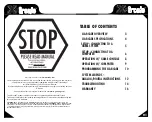
Month(Now)
' Holds the present value from 1 to 12.
Day(Now)
' Holds the present value from 1 to 31.
Year(Now)
' Holds the present value in 4 digit format (e.g. 2001).
Hour(Now)
' Holds the present value in 24 hour time from 0 to 23.
Minute(Now)
' Holds the present value from 0 to 59.
Second(Now)
' Holds the present value from 0 to 59.
Weekday(Now)
' Holds the present value from 0(Sunday) to 6(Saturday).
Example
: This program will set DataPointValue4 to 35 at midnight.
if
(Hour(Now)=0)
and
(Minute(Now)=0)
and
(Second(Now)=0)
then
DataPointValue4.Value = 35
end if
Programming methodology
There are three methods that will typically be used when creating a control system based on
a distributed control program. The method you choose will depend on your application, how
many units you have, and other factors which may be specific to your application. The three
methods are described below:
method 1
Your distributed control program performs all control logic. No logic programs run on the
SCADA units themselves.
Advantages
• This allows for centralized control and there is only one control program to cre
-
ate and maintain.
Disadvantages
• You will need all I/O points required for running your logic program to be on the
realtime screen.
• If the PC crashes or the program must be halted, then all control stops.
method 2
Your distributed control program only passes I/O information from one unit to another. All
control logic is performed in the SCADA units themselves using a C or Ladder program.
Information can easily be read from unit A and written into the C or ladder variables of unit B.
Advantages
• Control is performed locally at the SCADA unit. If the PC running the distrib
-
uted control program crashes or if the program must be halted, local control will
continue to function.
• This minimizes the number of I/O points on your realtime screen.
Disadvantages
• You will need to have separate control programs running for each SCADA unit
which may be more complicated to write and maintain.
method 3
A combination of Methods 1 & 2 where both the distributed control program runs control
logic and each SCADA unit also runs its own specific control program.
22-10
SCADA 3000 User’s Manual
Summary of Contents for Sensaphone SCADA 3000
Page 1: ...Sensaphone SCADA 3000 User s Manual Version 2 34...
Page 6: ...vi SCADA 3000 User s Manual...
Page 10: ...x SCADA 3000 User s Manual...
Page 30: ...1 6 SCADA 3000 User s Manual...
Page 48: ...4 6 SCADA 3000 User s Manual...
Page 70: ...9 8 SCADA 3000 User s Manual...
Page 122: ...12 8 SCADA 3000 User s Manual...
Page 190: ...15 30 SCADA 3000 User s Manual...
Page 211: ...lead 1 lag 0 else lead 0 lag 1 16 21 Chapter 16 Programming in C...
Page 212: ...16 22 SCADA 3000 User s Manual...
Page 236: ...21 8 SCADA 3000 User s Manual...
Page 248: ...22 12 SCADA 3000 User s Manual...
Page 258: ...23 10 SCADA 3000 User s Manual...
Page 274: ...25 8 SCADA 3000 User s Manual...
Page 288: ...27 8 SCADA 3000 User s Manual...
Page 294: ...28 6 SCADA 3000 User s Manual...
Page 296: ...A 2 SCADA 3000 User s Manual...
Page 302: ...D 2 SCADA 3000 User s Manual...
Page 318: ...I 2 SCADA 3000 User s Manual...
Page 320: ...J 2 SCADA 3000 User s Manual...
Page 322: ...K 2 SCADA 3000 User s Manual...
Page 335: ...Test Log...
Page 336: ......
















































